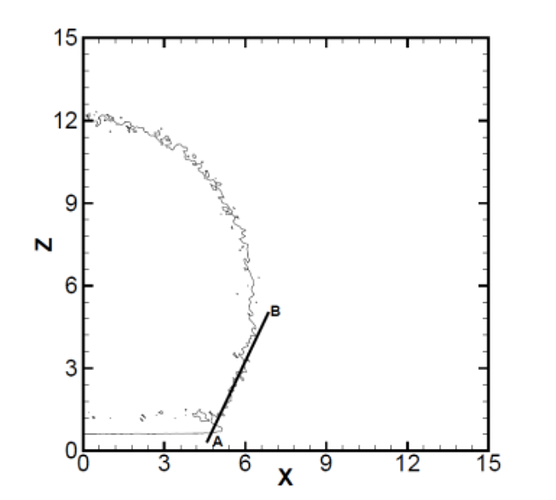My bad, I am describing everything here.
I want to simulate a stable nano droplet of Argon interacting with solid surface of Au substrate. I have to relax the structure first for stable nano droplet (No atoms flying out of the surface). I am running 100000 steps for that using nvt ensemble, and after that I am running another 100000 steps and I want to output density profile (Density vs radial distance) during these steps. From that profile, I want to calculate the contact angle of the liquid and solid surface.
My question is,
- How can I output density profile from which I can calculate contact angle?
I am putting up my code below,
stable Ar nanodroplet
units real
atom_style atomic
boundary s s s
processors 2 2 2
generate initial Ar structure by LAMMPS commands
lattice fcc 5.26
region box block -60 60 -60 60 -60 60
create_box 2 box
#################### Create Argon atoms #####################
region particle sphere 0 2 25 25 side out units box
create_atoms 1 box
delete_atoms region particle compress yes
mass 1 39.948
#################### Create Au atoms #####################
lattice fcc 2.95 orient x 1 0 0 orient y 0 1 0 orient z 0 0 1
region brocode block -10 10 -10 10 -5.9 0
create_atoms 2 region brocode
#delete_atoms region brocode compress yes
mass 2 196.967
#################### Define groups ####################
group argon type 1
group gold type 2
assign initial velocities
velocity all create 84 1928059 mom yes rot yes sum no dist gaussian
#################### LJ potentials for Argon ###########
pair_style lj/cut 15
pair_coeff 1 1 .24468 3.5 15
pair_style hybrid/overlay lj/cut 10
pair_coeff * * lj/cut .73404 3.5
#air_style lj/cut 10
#air_coeff 2 2 .24468 3.5
timestep 1
thermo 1000
thermo_style custom step temp pe etotal lx ly lz
dump config all custom 600000 Ar.droplet.config.* id type x y z vx vy vz
dump_modify config format line “%8d %5d %25.18g %25.18g %25.18g %20.13g %20.13g %20.13g”
relax nano-droplet
apply thermodynamic conditions / constrains here
fix 1 argon nvt temp 84 84 100.0
fix 3 argon momentum 1 linear 1 1 1
dump myDump all xyz 5000 movie.xyz
#dump_modify myDump element Ar
run 100000
################### Continuie to run to output density profile for contact angle############
unfix 1
unfix 3
fix 1 argon nvt temp 84 84 100.0
fix 3 argon momentum 1 linear 1 1 1
#compute densitymap argon chunk/atom bin/cylinder 0 2 25 2 25 50 discard yes
#compute densitymap argon chunk/atom bin/cylinder z center 1 30 30 0 40 40 discard yes units lattice
#fix 103 argon ave/chunk 10 10 100 densitymap density/mass norm sample ave running file densitymap.txt overwrite
run 100000
